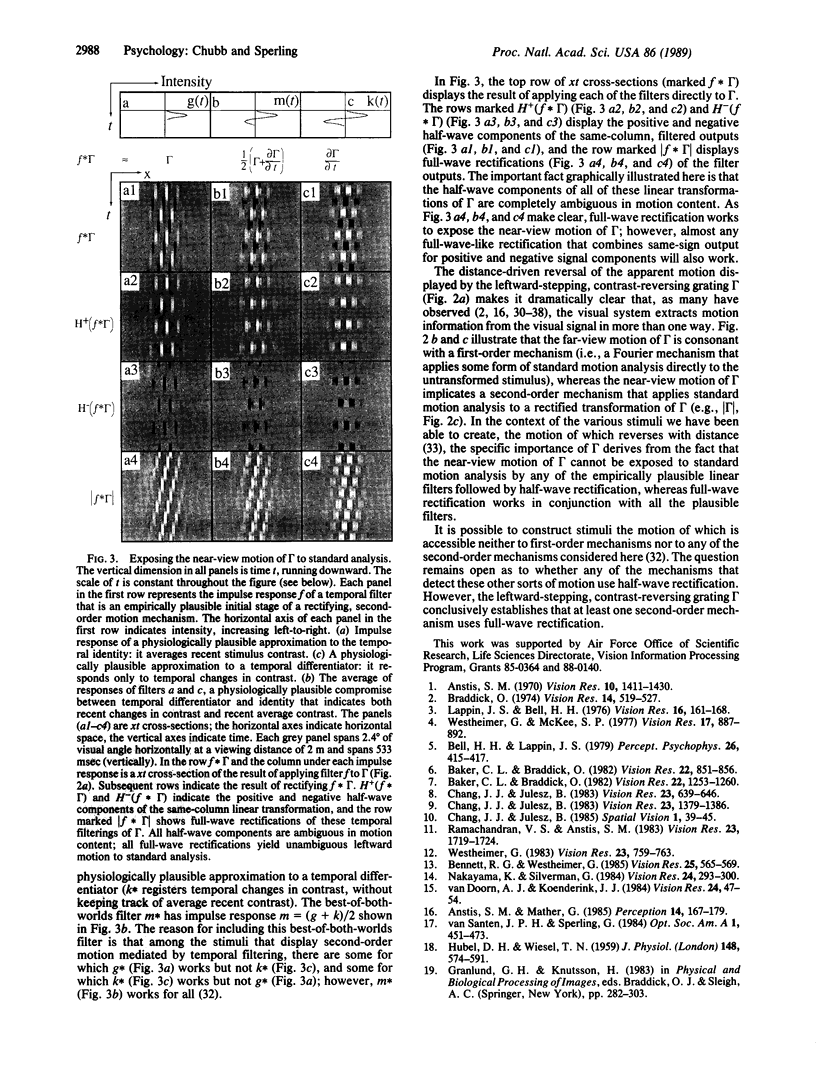Abstract
We demonstrate two kinds of visual stimuli that exhibit motion in one direction when viewed from near and in the opposite direction from afar. These striking reversals occur because each kind of stimulus is constructed to simultaneously activate two different mechanisms: a short-range mechanism that computes motion from space-time correspondences in stimulus luminance and a long-range mechanism in which motion computations are performed, instead, on stimulus contrast that has been full-wave rectified (e.g., on the absolute value of contrast).
Full text
PDF




Images in this article
Selected References
These references are in PubMed. This may not be the complete list of references from this article.
- Adelson E. H., Bergen J. R. Spatiotemporal energy models for the perception of motion. J Opt Soc Am A. 1985 Feb;2(2):284–299. doi: 10.1364/josaa.2.000284. [DOI] [PubMed] [Google Scholar]
- Anstis S. M., Mather G. Effects of luminance and contrast on direction of ambiguous apparent motion. Perception. 1985;14(2):167–179. doi: 10.1068/p140167. [DOI] [PubMed] [Google Scholar]
- Anstis S. M. Phi movement as a subtraction process. Vision Res. 1970 Dec;10(12):1411–1430. doi: 10.1016/0042-6989(70)90092-1. [DOI] [PubMed] [Google Scholar]
- Baker C. L., Jr, Braddick O. J. Does segregation of differently moving areas depend on relative or absolute displacement? Vision Res. 1982;22(7):851–856. doi: 10.1016/0042-6989(82)90019-0. [DOI] [PubMed] [Google Scholar]
- Baker C. L., Jr, Braddick O. J. The basis of area and dot number effects in random dot motion perception. Vision Res. 1982;22(10):1253–1259. doi: 10.1016/0042-6989(82)90137-7. [DOI] [PubMed] [Google Scholar]
- Bennett R. G., Westheimer G. A shift in the perceived simultaneity of adjacent visual stimuli following adaptation to stroboscopic motion along the same axis. Vision Res. 1985;25(4):565–569. doi: 10.1016/0042-6989(85)90161-0. [DOI] [PubMed] [Google Scholar]
- Braddick O. A short-range process in apparent motion. Vision Res. 1974 Jul;14(7):519–527. doi: 10.1016/0042-6989(74)90041-8. [DOI] [PubMed] [Google Scholar]
- Chang J. J., Julesz B. Cooperative and non-cooperative processes of apparent movement of random-dot cinematograms. Spat Vis. 1985;1(1):39–45. doi: 10.1163/156856885x00062. [DOI] [PubMed] [Google Scholar]
- Chang J. J., Julesz B. Displacement limits for spatial frequency filtered random-dot cinematograms in apparent motion. Vision Res. 1983;23(12):1379–1385. doi: 10.1016/0042-6989(83)90149-9. [DOI] [PubMed] [Google Scholar]
- Chang J. J., Julesz B. Displacement limits, directional anisotropy and direction versus form discrimination in random-dot cinematograms. Vision Res. 1983;23(6):639–646. doi: 10.1016/0042-6989(83)90070-6. [DOI] [PubMed] [Google Scholar]
- Chubb C., Sperling G. Drift-balanced random stimuli: a general basis for studying non-Fourier motion perception. J Opt Soc Am A. 1988 Nov;5(11):1986–2007. doi: 10.1364/josaa.5.001986. [DOI] [PubMed] [Google Scholar]
- HUBEL D. H., WIESEL T. N. Receptive fields of single neurones in the cat's striate cortex. J Physiol. 1959 Oct;148:574–591. doi: 10.1113/jphysiol.1959.sp006308. [DOI] [PMC free article] [PubMed] [Google Scholar]
- Heeger D. J. Model for the extraction of image flow. J Opt Soc Am A. 1987 Aug;4(8):1455–1471. doi: 10.1364/josaa.4.001455. [DOI] [PubMed] [Google Scholar]
- Lappin J. S., Bell H. H. The detection of coherence in moving random-dot patterns. Vision Res. 1976;16(2):161–168. doi: 10.1016/0042-6989(76)90093-6. [DOI] [PubMed] [Google Scholar]
- Lelkens A. M., Koenderink J. J. Illusory motion in visual displays. Vision Res. 1984;24(9):1083–1090. doi: 10.1016/0042-6989(84)90086-5. [DOI] [PubMed] [Google Scholar]
- Nakayama K., Silverman G. H. Temporal and spatial characteristics of the upper displacement limit for motion in random dots. Vision Res. 1984;24(4):293–299. doi: 10.1016/0042-6989(84)90054-3. [DOI] [PubMed] [Google Scholar]
- Pantle A., Picciano L. A multistable movement display: evidence for two separate motion systems in human vision. Science. 1976 Aug 6;193(4252):500–502. doi: 10.1126/science.941023. [DOI] [PubMed] [Google Scholar]
- Ramachandran V. S., Anstis S. M. Displacement thresholds for coherent apparent motion in random dot-patterns. Vision Res. 1983;23(12):1719–1724. doi: 10.1016/0042-6989(83)90188-8. [DOI] [PubMed] [Google Scholar]
- Reichardt W., Egelhaaf M., Schlögl R. W. Movement detectors provide sufficient information for local computation of 2-D velocity field. Naturwissenschaften. 1988 Jun;75(6):313–315. doi: 10.1007/BF00367326. [DOI] [PubMed] [Google Scholar]
- Watson A. B., Ahumada A. J., Jr Model of human visual-motion sensing. J Opt Soc Am A. 1985 Feb;2(2):322–341. doi: 10.1364/josaa.2.000322. [DOI] [PubMed] [Google Scholar]
- Watt R. J., Morgan M. J. A theory of the primitive spatial code in human vision. Vision Res. 1985;25(11):1661–1674. doi: 10.1016/0042-6989(85)90138-5. [DOI] [PubMed] [Google Scholar]
- Westheimer G., McKee S. P. Perception of temporal order in adjacent visual stimuli. Vision Res. 1977;17(8):887–892. doi: 10.1016/0042-6989(77)90062-1. [DOI] [PubMed] [Google Scholar]
- Westheimer G. Temporal order detection for foveal and peripheral visual stimuli. Vision Res. 1983;23(8):759–763. doi: 10.1016/0042-6989(83)90197-9. [DOI] [PubMed] [Google Scholar]
- van Doorn A. J., Koenderink J. J. Spatiotemporal integration in the detection of coherent motion. Vision Res. 1984;24(1):47–53. doi: 10.1016/0042-6989(84)90143-3. [DOI] [PubMed] [Google Scholar]
- van Santen J. P., Sperling G. Elaborated Reichardt detectors. J Opt Soc Am A. 1985 Feb;2(2):300–321. doi: 10.1364/josaa.2.000300. [DOI] [PubMed] [Google Scholar]
- van Santen J. P., Sperling G. Temporal covariance model of human motion perception. J Opt Soc Am A. 1984 May;1(5):451–473. doi: 10.1364/josaa.1.000451. [DOI] [PubMed] [Google Scholar]





